South Korea is a fascinating country with its unique blend of heritage and technological development; colorful imperial palaces and ancient temples nestled between modern skyscrapers, traditional tea houses and modern Korean cuisine restaurants, Korean people wearing traditional hanboks when visiting historical sites and Koreans donning the last trends when walking through the liveliest Seoul’s district.
Rich cultural heritage of Korea as well as modern economical and technological success are naturally boosting Korean manufacturing and result in many interesting Korean products, some of them difficult to find (or much more expensive) outside of the country.
South Korea Since South Korea is still not very touristy place, you can find here many boutiques selling quality items at fair prices. Haggling is not common, at since many of the shops cater often to the local people who appreciate their native products, you rarely can get yourself in tourist scams or elevated prices.
The main difficulty coming from the fact that Korea is not flooded with tourists is where to search for your perfect souvenirs for yourself and your loved ones during the trip.
From my own experience, the best place for shopping is lively Seoul with few spots with bigger concentration of shops where high quality and authentic Korean products are sold.
Check out this post to see my itinerary in Seoul:
Culturally-packed visit to Seoul. What to see in 3 days to learn more about South Korea?
If you’re searching for traditional souvenirs like items made of mother of pearl lacquerware, Korean fans, historical figures or traditional tableware like metal chopsticks or soju sets then the Korean Heritage souvenir stores inside of Changdeokgung, Gyeongbokgung and Deoksugung Palaces are good places to start your search, the selection is not very extensive but the products are authentic, of good quality and fairly priced. If you don’t have much time for shopping in Seoul and want to buy traditional products made of Korea then this is a good address.
If you’re interested in Korean beauty market then Myeong-dong area is the best place for shopping with many popular Korean cosmetic brands having boutiques here, some of them have here the flagship stores with really big selection. I saw discounts in most of the stores and Korean people buying cosmetics in the area so even if it looks touristy, this is in fact a spot with big concentration of beauty shops where the locals also come for convenience. If you plan bigger shopping, bring your passport to enjoy tax-free scheme.
If search for diversity, with both traditional souvenirs as well as modern gadgets, Korean pop culture themed items, Korean food products, and various handicrafts, then Insan-dong area is a good choice. You will find here plenty of Korean products and the selection is really vast, I suggest coming here at the end of your stay to complete your souvenir to-buy list. Note however, that quality may vary from shop to shop. Some of the stores are a family business having a long tradition with really high quality objects, some sell authentic Korean handicrafts but you can also see shops with products which are cheaper copies and not made in Korea so always check the description on the tags, ask the seller and visually assess the item. To ensure that your souvenir is made in South Korea, check in Google Translate how to write the name of the country in Korean and then compare with the description on the tag.
In this post I will give you a list of 20 authentic and traditional souvenirs from South Korea which you can bring back from your journey as a perfect souvenir.
- Mother of pearl Korean box
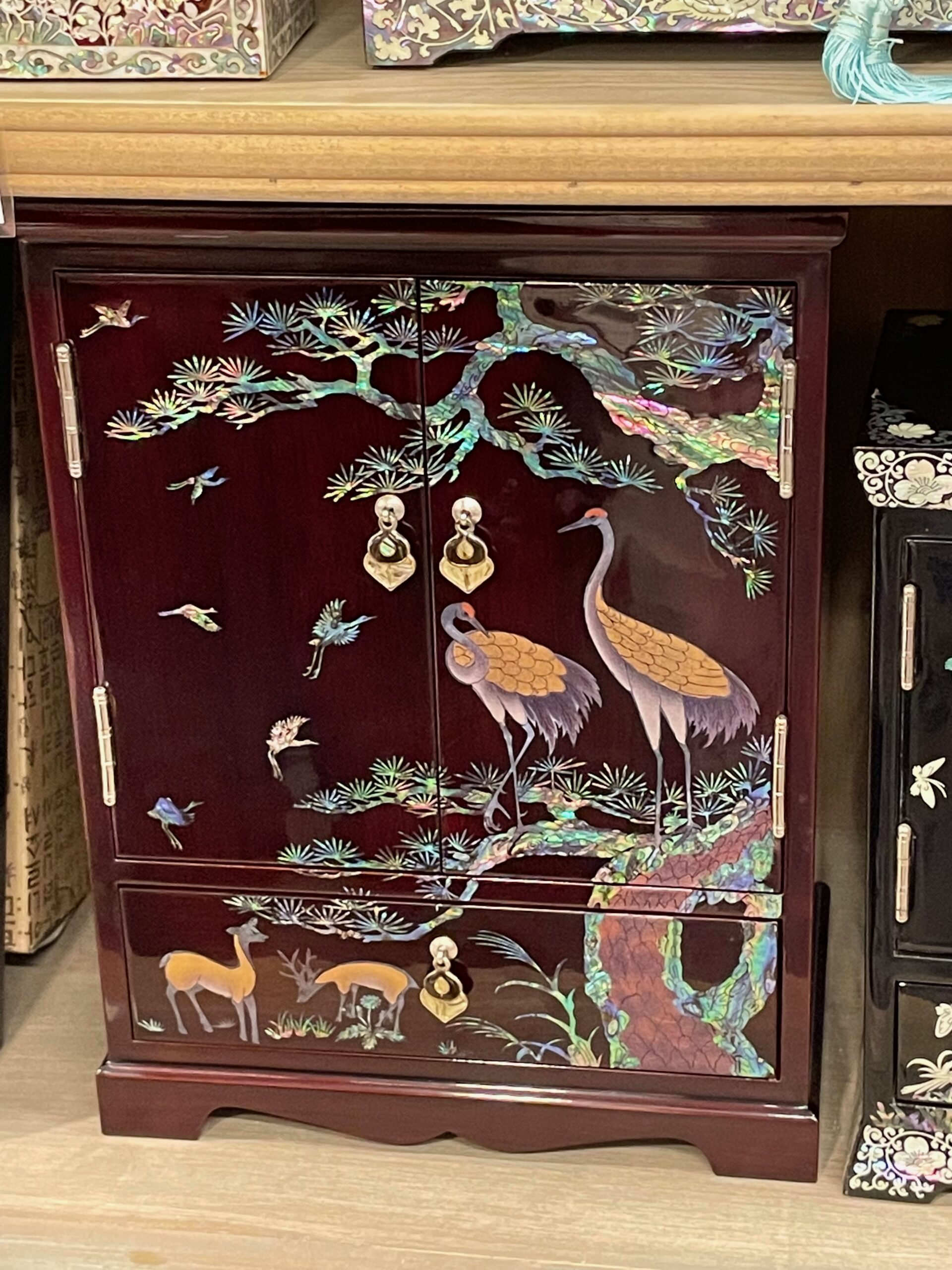 |
Mother of pearl Korean boxes are traditional and exquisite pieces of Korean craftsmanship that have been cherished for centuries. The boxes are renowned for their intricate design, meticulous attention to detail, and the use of mother-of-pearl inlay techniques that create stunning, iridescent patterns. Their usually made of wood. Common motifs found on these boxes include phoenixes, dragons, lotus flowers, cranes, and various other symbols representing longevity, good fortune, and prosperity. They come in different shapes and sizes, with some designed for jewelry storage, while others may be used to store precious items like documents, calligraphy brushes, or even tea sets. The boxes are known for their durability and ability to protect the stored items.
The more intricate are the patterns and the bigger is the size, the higher price of the piece. I recommend checking out the Korean heritage shops on the grounds of the imperial palaces in Seoul if you’re searching for smaller boxes. The selection is not very big, but the boxes are of high quality, made in Korea and at good prices.
- Ginseng products
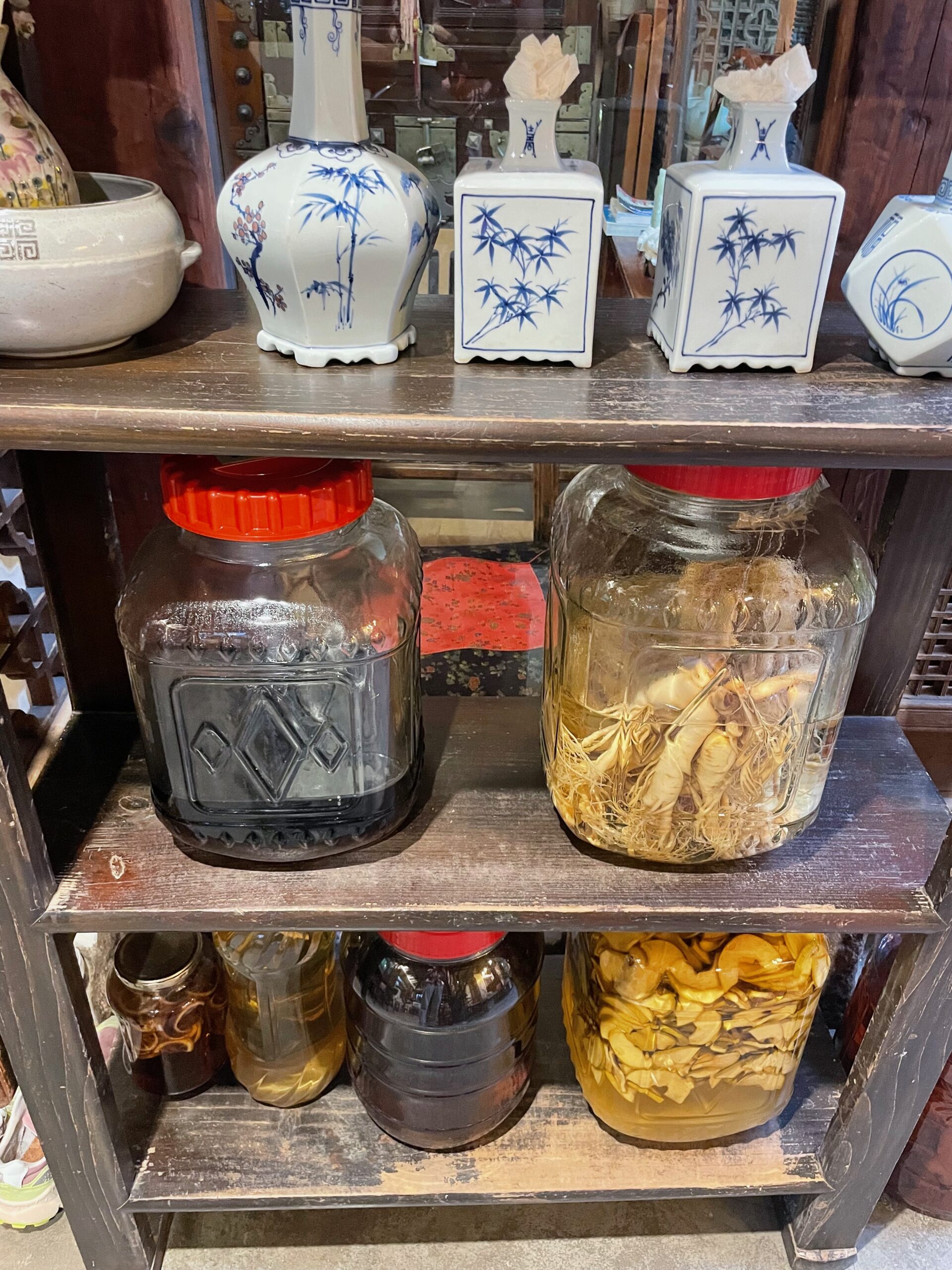 |
Ginseng is a highly prized and revered herbal remedy with a rich history of use in traditional Korean medicine. Known for its unique properties and potential health benefits, Korean ginseng has gained international recognition and is often considered one of the finest ginseng varieties available. Korean ginseng is traditionally used to reduce stress, increase the stamina and combat fatigue, boost the immune system and for many other health purposes. Korean ginseng can be bought in various forms, including raw, dried, and processed into supplements, extracts, teas, and tonics. There is also plenty of beauty products such as creams, masks and serums having ginseng as an ingredient. If you’re searching for extracts, teas, sweets or raw or dried versions of ginseng check out Namdaemun Market in the centre of Seoul. The market is known for vast ginseng selection of products and the prices are lower than in the regular shops.
- Korean beauty products
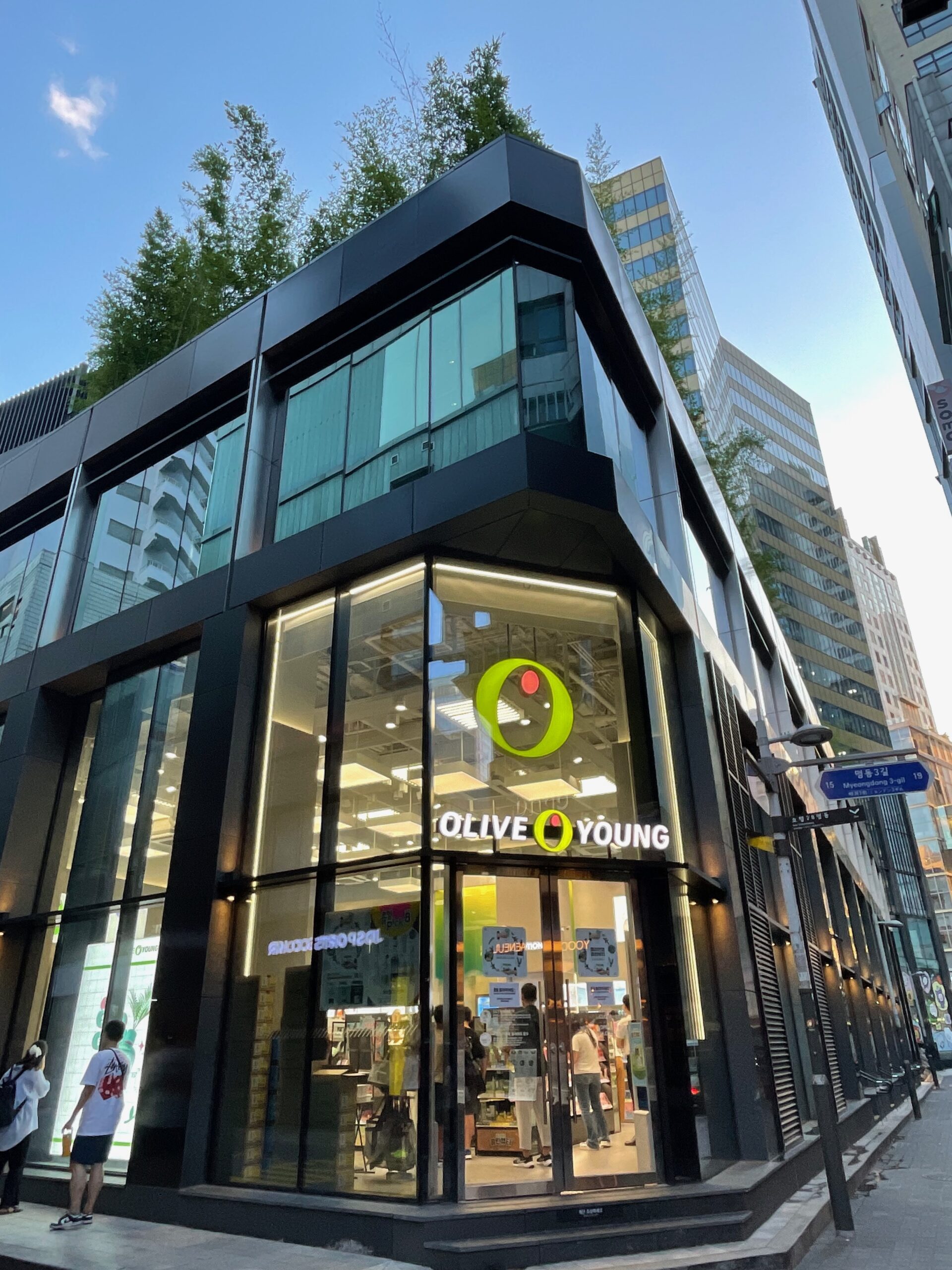 |
Korean beauty products, often referred to as K-beauty products, have taken the beauty and skincare world by storm in recent years. Renowned for their innovative formulations, high-quality ingredients, and meticulous attention to detail, K-beauty products have gained a dedicated following worldwide. One of the hallmark features of K-beauty is the emphasis on a multi-step skincare routine including cleansing, toning, essence, serums, sheet masks, moisturizing, and sun protection. This extensive routine is believed to promote healthy, radiant skin by addressing various skincare concerns in a comprehensive manner. One of the most famous K-beauty products are probably the face masks which are soaked in serums or essences and are designed to provide intense hydration and address specific skin concerns. Korean BB creams and cushion compacts as well as face protection creams are also worldwide known. For a big concentration of beauty shops in Seoul, I recommend coming to Myeong-dong street. Many brands have their flagship stores here. If you’re new to K-beauty and don’t have favorite products I suggest coming to Olive Young which is a cosmetic chain store selling various Korean brands. This is a good place to navigate through Korean beauty brands, test different products and in case you like particular marque, you can proceed to its store (where the selection will be bigger) which most probably is also located in Myeong-dong, convenient, isn’t it?
4. Korean Celadon Chinaware
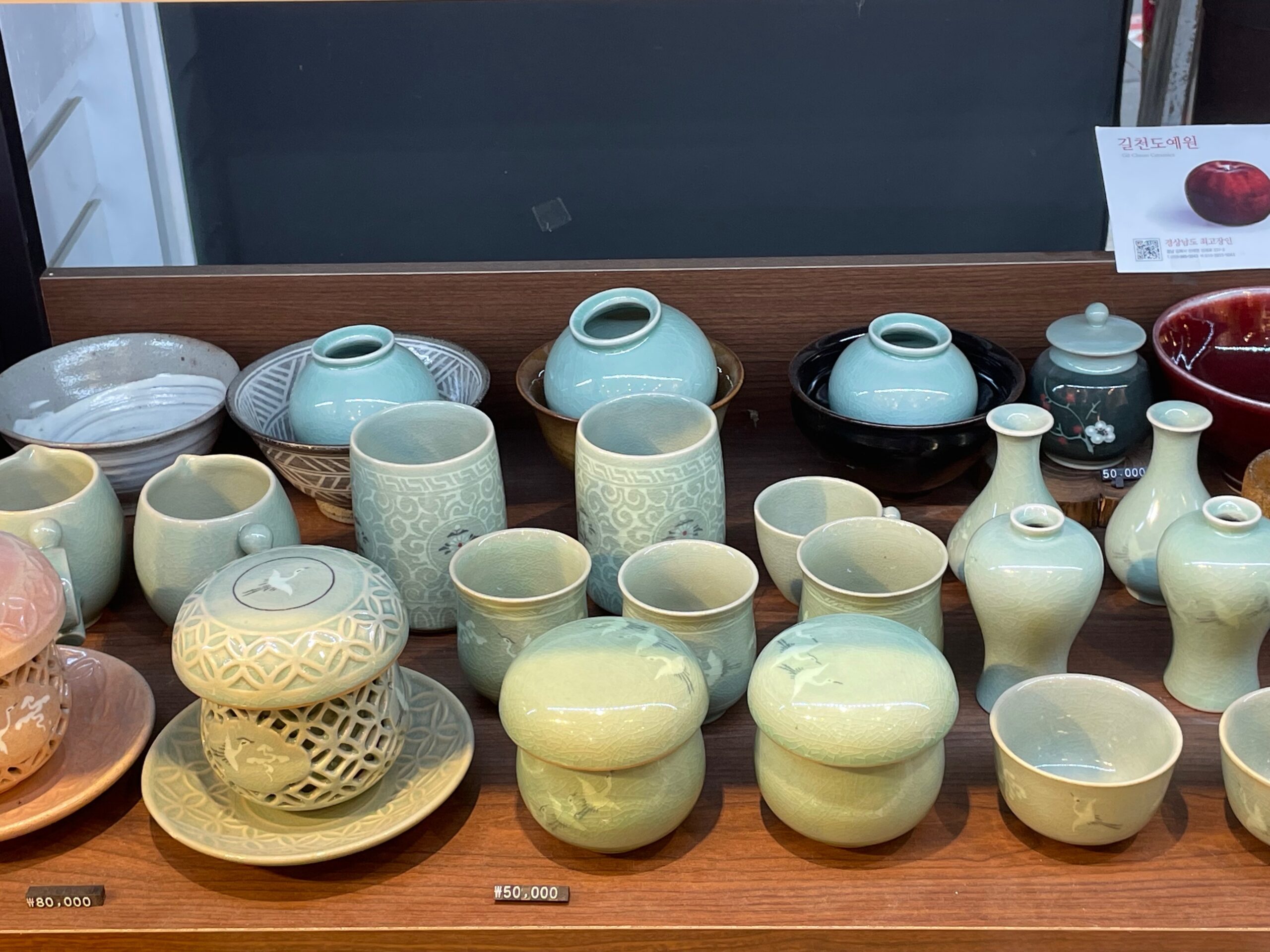 |
Korean Celadon chinaware, often referred to as “Cheongja” or “Joseon Celadon,” is a renowned and exquisite type of pottery that holds a special place in the history of Korean ceramics. It is celebrated for its distinctive greenish-blue glaze and intricate, delicate designs. Korean Celadon has a long and storied history, and its craftsmanship reflects the skill and artistic sensibility of Korean potters through the ages. Today, Korean Celadon chinaware continues to be highly valued and collected both in Korea and internationally. It represents the timeless beauty and craftsmanship of Korean ceramics, serving as a tangible link to Korea’s rich cultural heritage. If you search for your own beautiful Celadon vase, kettle, mug or set of plates, check out the shops in Insan-dong area. Try to look for boutiques selling more artisanal products or which specialize in Celadon Chinaware to ensure quality.
5. Korean fan
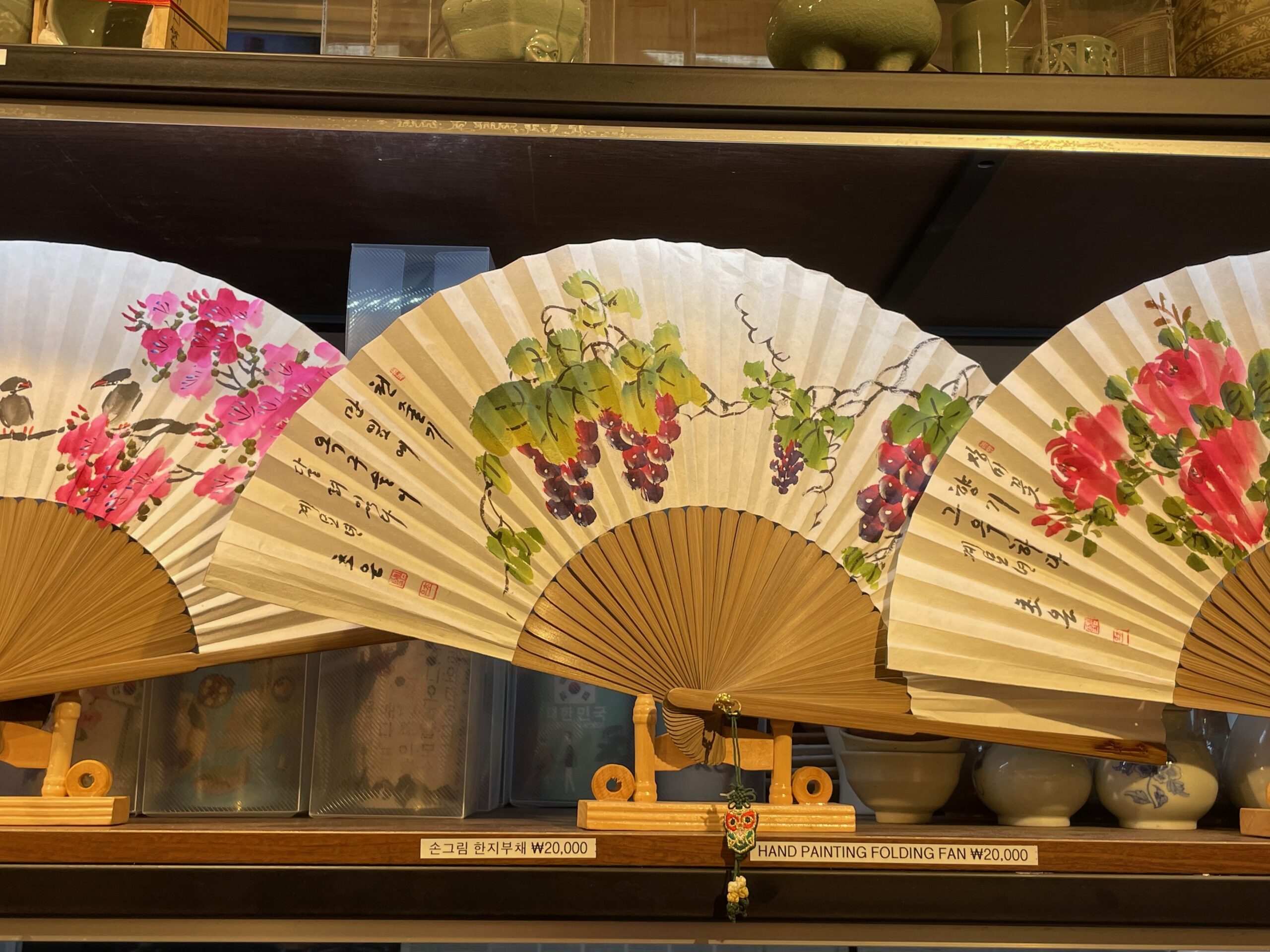 |
Korean fans, often referred to as “uchiwa” or “부채” (buchaeb) in Korean, are traditional handheld fans that have been an integral part of Korean culture for centuries. Korean fans were initially designed to provide relief from the sweltering Korean summers. Their ability to create a gentle breeze made them essential accessories for staying cool and comfortable in the hot and humid climate. The fans are also appreciated for their beauty, craftsmanship, and cultural significance. They have played a significant role in various traditional ceremonies, performances, and rituals. They are often used by dancers, musicians, and actors to enhance their movements and add a touch of elegance to their performances. Fans have also been used as props in traditional Korean dance forms like Buchaechum. Nowadays you can find many artisanal shops selling beautiful unique handmade fans, choose more decorative ones (also often more fragile) if you want to hang them in your house as an ornament. Choose simpler cotton and silk fans if you want to use them in the summer to cool down during heat. Insan-dong area has many shops which sell beautiful Korean fans.
6. Metal chopsticks
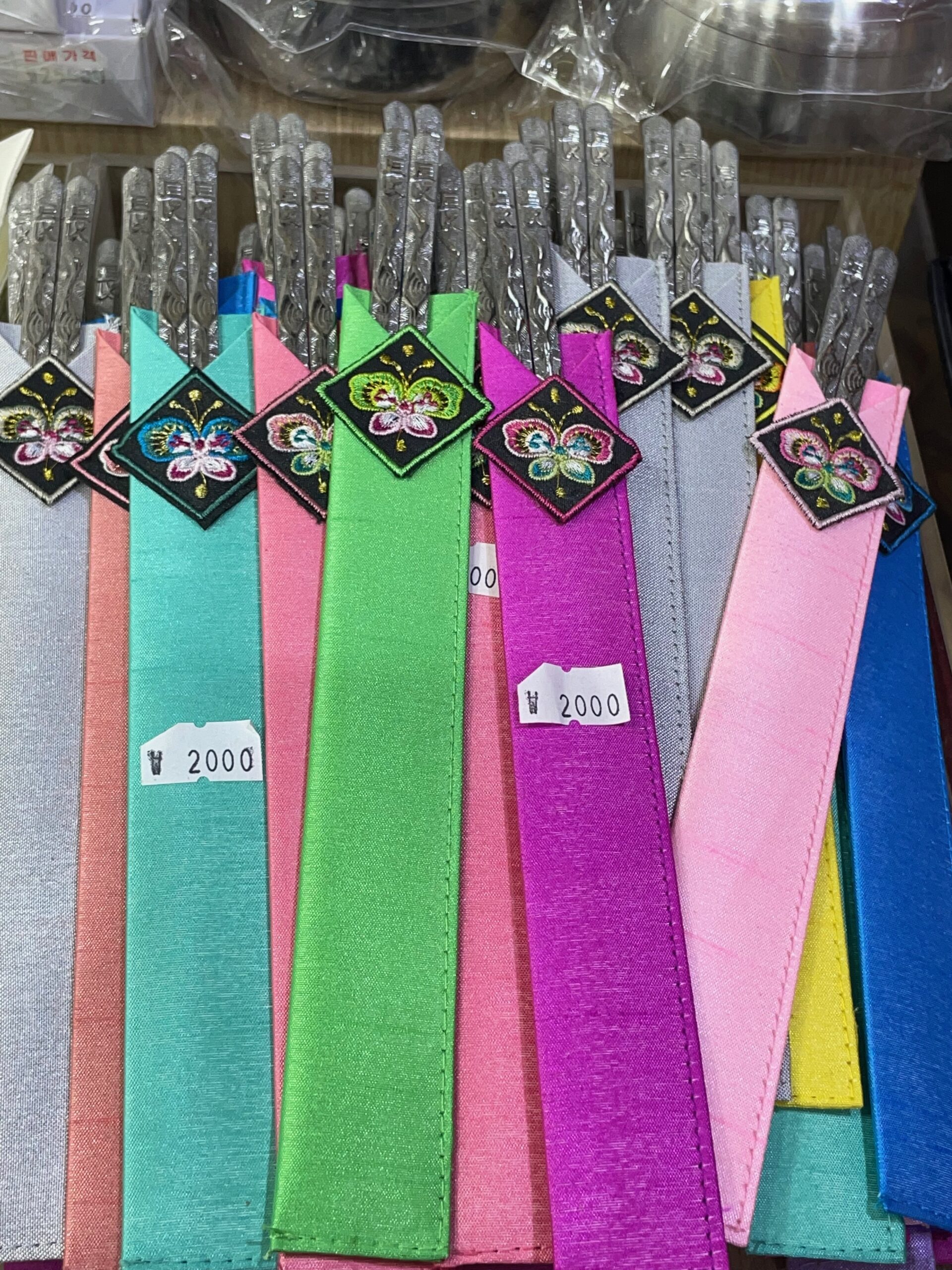 |
Did you know that Koreans use metal chopsticks as their eating utensils opposite to wooden or bamboo chopsticks which are common in many other East Asian countries? These metal chopsticks have a long history in Korean cuisine and come with their own set of characteristics and cultural significance. Korean metal chopsticks are typically made from stainless steel, brass, or other non-corrosive metals. This choice of material makes them highly durable, long-lasting, and easy to maintain. Unlike wooden or bamboo chopsticks, they don’t splinter or wear out over time. One of the primary reasons for the use of metal chopsticks in Korea is their practicality. Korean cuisine often includes dishes that involve grilling, stir-frying, and serving food in hot pots. Metal chopsticks are well-suited for these cooking methods, as they don’t get damaged or stained by heat, oil, or sauces. The chopsticks are also easy to clean and sterilize, which is crucial for maintaining proper hygiene, especially in communal dining settings. They are less porous than wooden chopsticks, making them less susceptible to retaining food particles and odors. If the advantages of metal chopsticks speak to you, you can bring them as souvenirs and use at home when serving East Asian cuisine dishes. You probably find them in your home country too, but those bought in Korea will remind you about your trip whenever you use them. The prices of such an essential Korean good can also be better priced here. If you search for some fancier sets check the Korean Heritage store in one of the Imperial Palaces in Seoul or Insan-dong area. If you want to buy chopsticks which Koreans use in their homes, just pop into one of the bigger kitchenware stores in any Korean city you visit.
7. Soju
Korean soju is a clear, colorless spirit with a relatively low alcohol content, usually around 20-25% alcohol by volume. The beverage is often enjoyed during meals, particularly with Korean barbecue, as it complements the flavors of grilled meats and spicy dishes. There are different varieties of soju, including flavored and fruit-infused options. Classic soju is clear and typically unflavored, while fruit-flavored soju, like peach or grape, has gained popularity in recent years. These fruit-infused sojus are usually sweeter and easier to drink. Soju is often served in small, shot glass-sized cups called “soju glasses.” It is customary to pour and receive soju with both hands as a sign of respect in Korean culture. Soju is typically enjoyed neat, but it’s also common to mix it with other beverages like beer, creating a popular cocktail known as “SoMaek.” If you like soju in South Korea, it can be fun to bring also a set of soju glasses home, the beverage can be easily found in Korean or Asian supermarkets abroad. As for buying soju in South Korea, the spirit is widely available in any supermarket, if you want to try something more elaborate, try a specialized store. Soju is also served in majority of restaurants so you can have some testing before to check if the beverage is your thing.
8. Korean tea
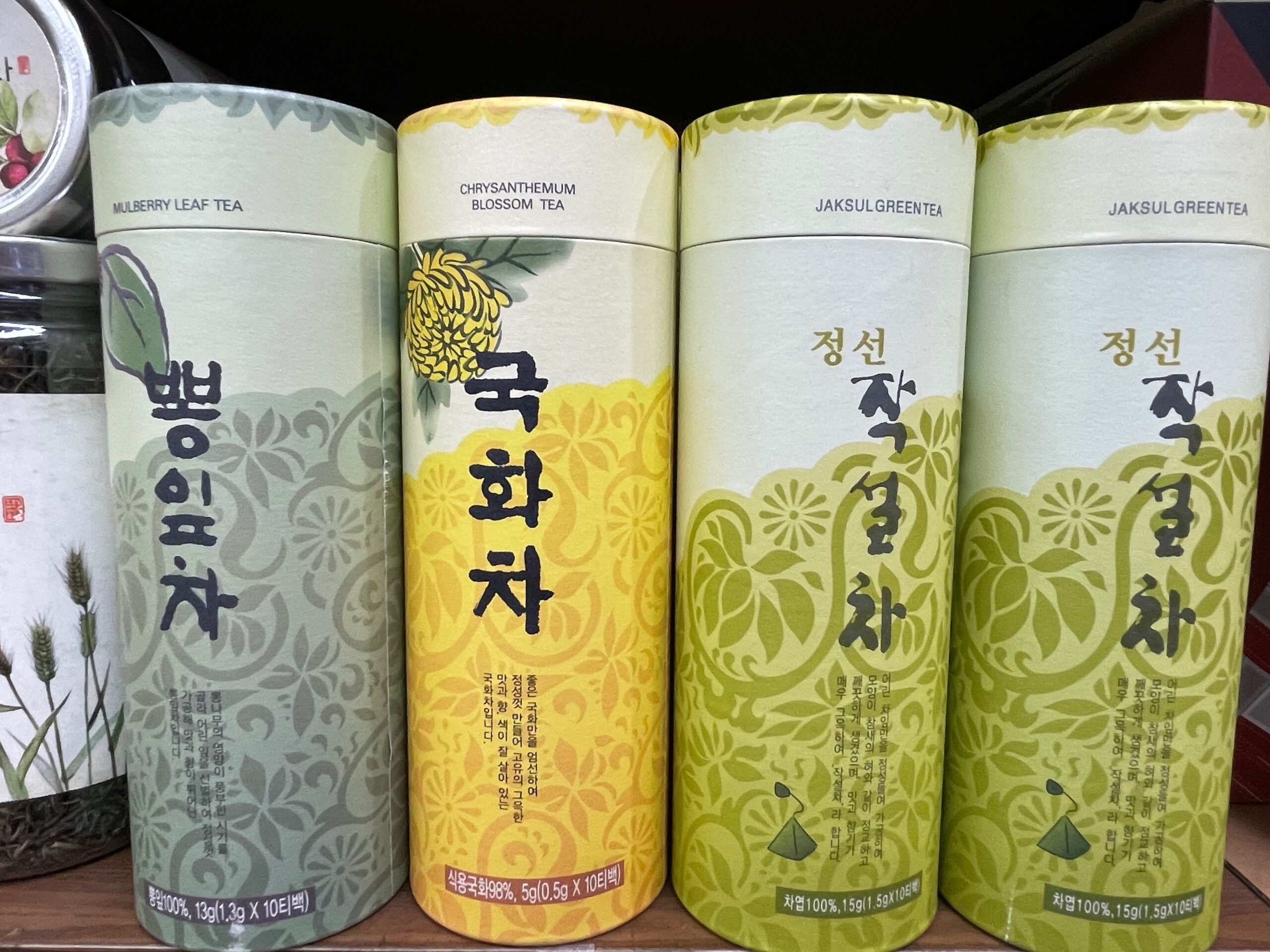 |
Whereas Japanese and Chinese teas are widely known and easily available worldwide, Korea has also a very interesting selection for the tea lovers. In fact, Korean tea culture has a rich history that dates back centuries, and the country is known for a variety of traditional teas that offer a unique and diverse range of flavors and health benefits. Here are some of the most popular types of Korean tea:
- green tea (Nokcha): green tea is one of the most common and beloved types of tea in Korea. Korean green tea is often pan-fired and has a slightly more savory, vegetal flavor compared to other green teas. One of the most famous varieties is Boseong green tea, which is grown in the Boseong region;
- jasmine tea (Mogwa Cha): this tea is made by infusing green tea leaves with jasmine flowers. The result is a fragrant and delicate tea with a slightly sweet and floral aroma. Jasmine tea is known for its soothing and calming properties;
- barley tea (Boricha): barley tea is a common beverage in Korea, especially during the summertime. It’s made by roasting barley grains, which gives the tea a toasty and nutty flavor. Barley tea is often served cold and is a popular choice for hydration;
- ginger tea (Saenggang Cha): ginger tea is made by boiling fresh ginger slices with honey or sugar. It has a spicy, warming flavor and is often consumed to alleviate cold symptoms or soothe an upset stomach. Ginger tea is also known for its digestive properties;
- Korean red ginseng tea (Hongsam Cha): this tea is made from the root of the Korean red ginseng, which is well-known for its medicinal qualities. It has a slightly bitter taste and is believed to boost energy and strengthen the immune system. Korean red ginseng tea is often served hot and sweetened;
- Lotus leaf tea (Yeonip Cha): lotus leaf tea is made from the leaves of the lotus plant. It has a mild, herbal taste and is believed to aid digestion and promote relaxation.
You can buy different types of Korean tea in usual supermarkets, however if you search for a bigger selection, high quality tea or need some advice, it’s better to go shopping to stores which specialize in selling tea.
9. Statement socks
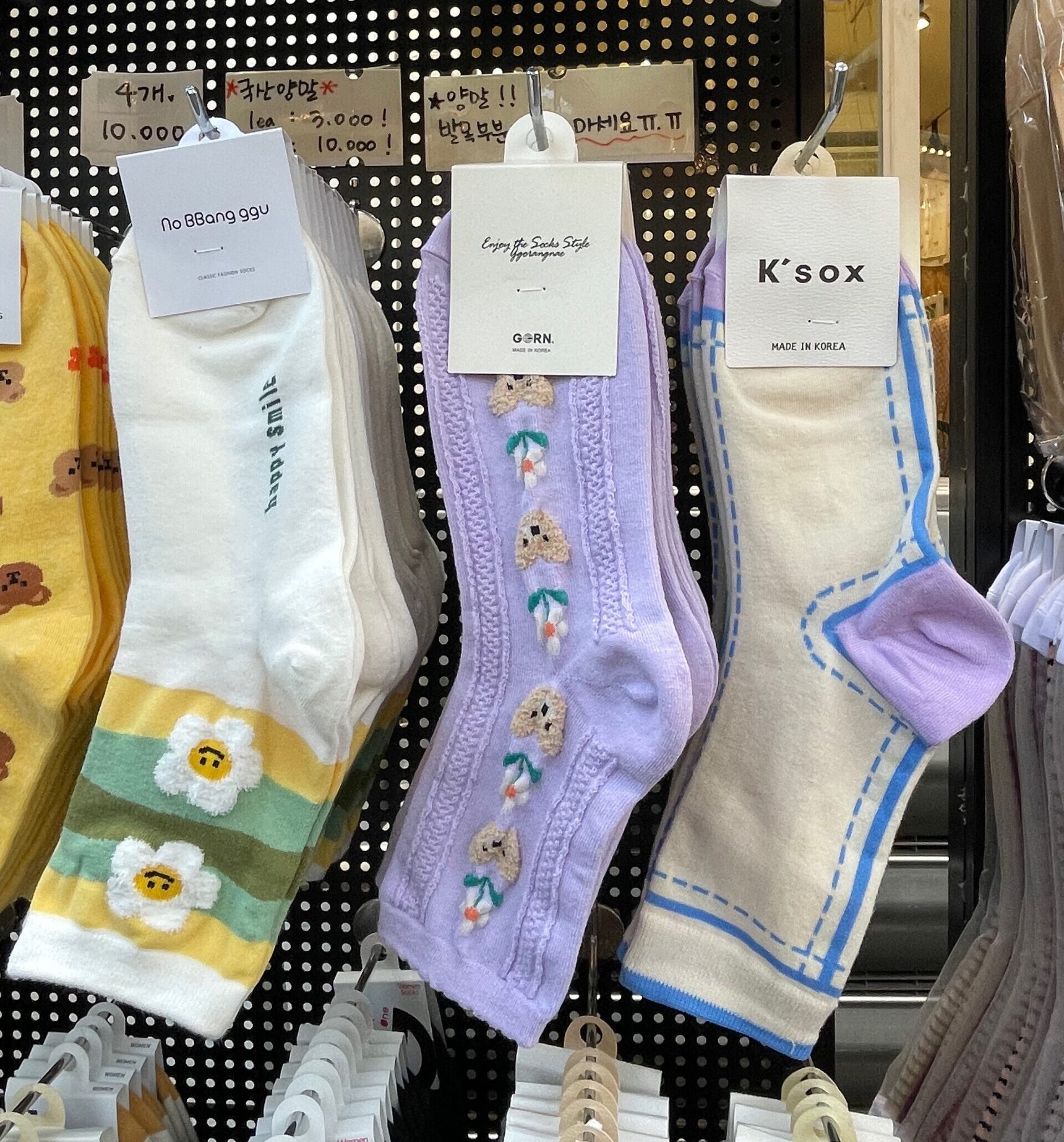 |
If you walk through Korean towns, you will that fancy socks are a thing. You will see many shops selling socks with different prints and patterns. Korean sock fashion is influenced by trends in K-pop and Korean drama, where celebrities often sport unique and eye-catching socks. These trends can include statement socks with bold prints and slogans. Socks have become a creative and expressive fashion accessory in South Korea. Whether you’re looking for socks to complete your outfit or to showcase your personality, Korean sock shops offer a wide variety of options to suit your style and preferences. The dynamic and diverse world of Korean sock fashion continues to evolve and set new trends in the world of fashion.
Finding stores selling trendy socks is easy, they are practically everywhere, even in stores in Seoul’s underground’s corridors. Before making your purchase, check out the composition and country of production to ensure you buy good quality socks.
10. K-Pop and K-Drama gadgets
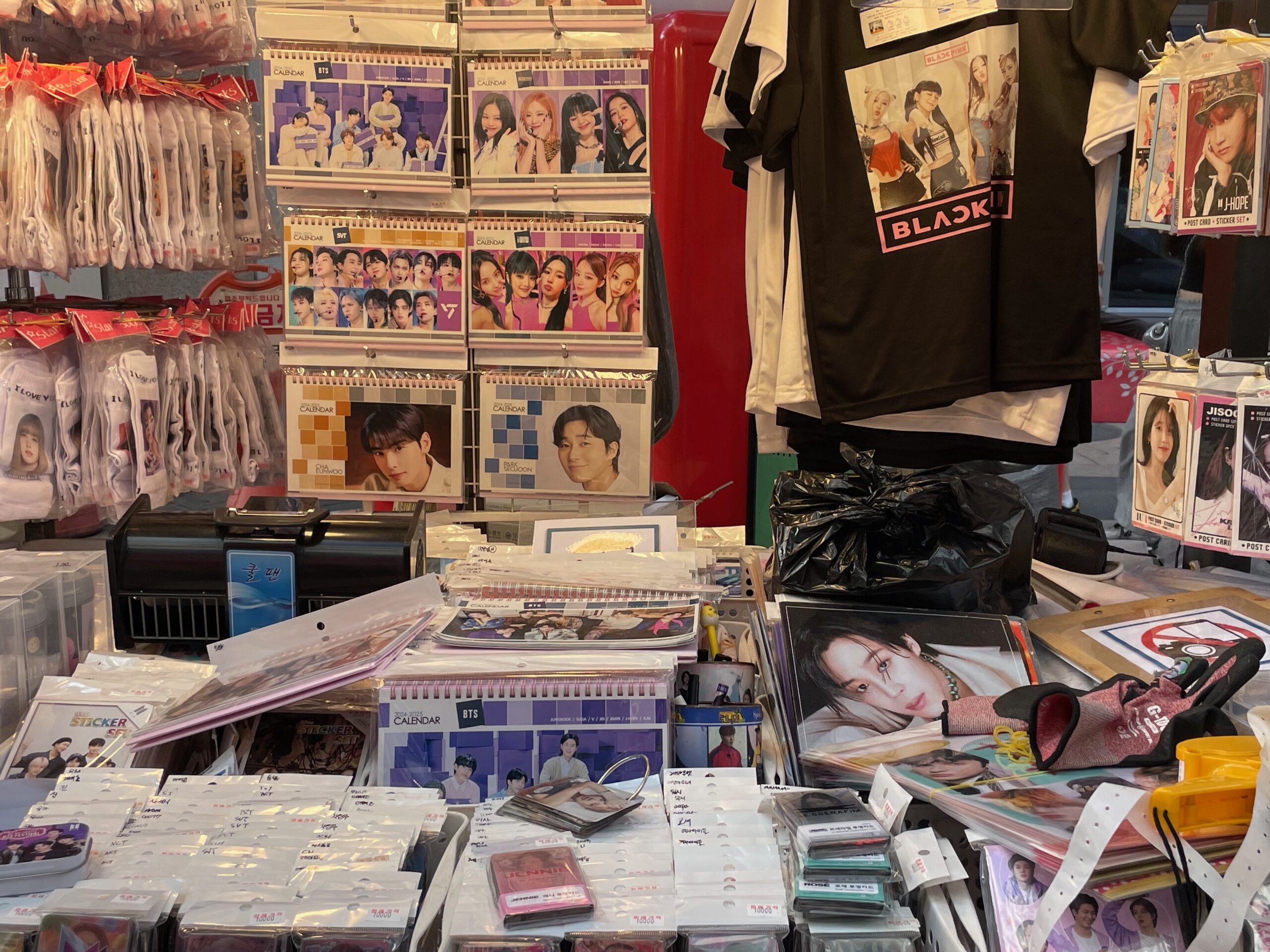 |
If you’re an avid listener of Korean pop or can’t wait to see another episode of your favourite K-Drama, you probably will be searching for themed gadgets. If you’re not familiar with these famous Korean genres K-Pop and K-Drama are two of South Korea’s most significant cultural exports, and they have gained immense popularity on the global stage. K-Pop is characterized by its catchy tunes, impressive choreography, and visually stunning music videos. It’s known for its high-energy performances, where groups of talented singers and dancers come together to create music that often combines various genres like pop, hip-hop, and electronic music. K-Drama refers to Korean television dramas, which have become increasingly popular worldwide. They encompass a wide range of genres, from romance and melodrama to action, fantasy, and historical settings. K-Dramas are known for their captivating storylines, well-developed characters, and emotional depth. Many K-Dramas explore themes like love, family, friendship, and personal growth. They often feature complex, multi-episode plots that allow for in-depth character development.
When walking around Seoul I saw many shops and stalls selling T-shirts, posters, mugs and other collector items with pictures of the K-Pop music bands or actors from K-Dramas. I saw many stalls with may items with K-Pop and K-Drama themes in Myeong-dong area.
11. Traditional Korean sweets
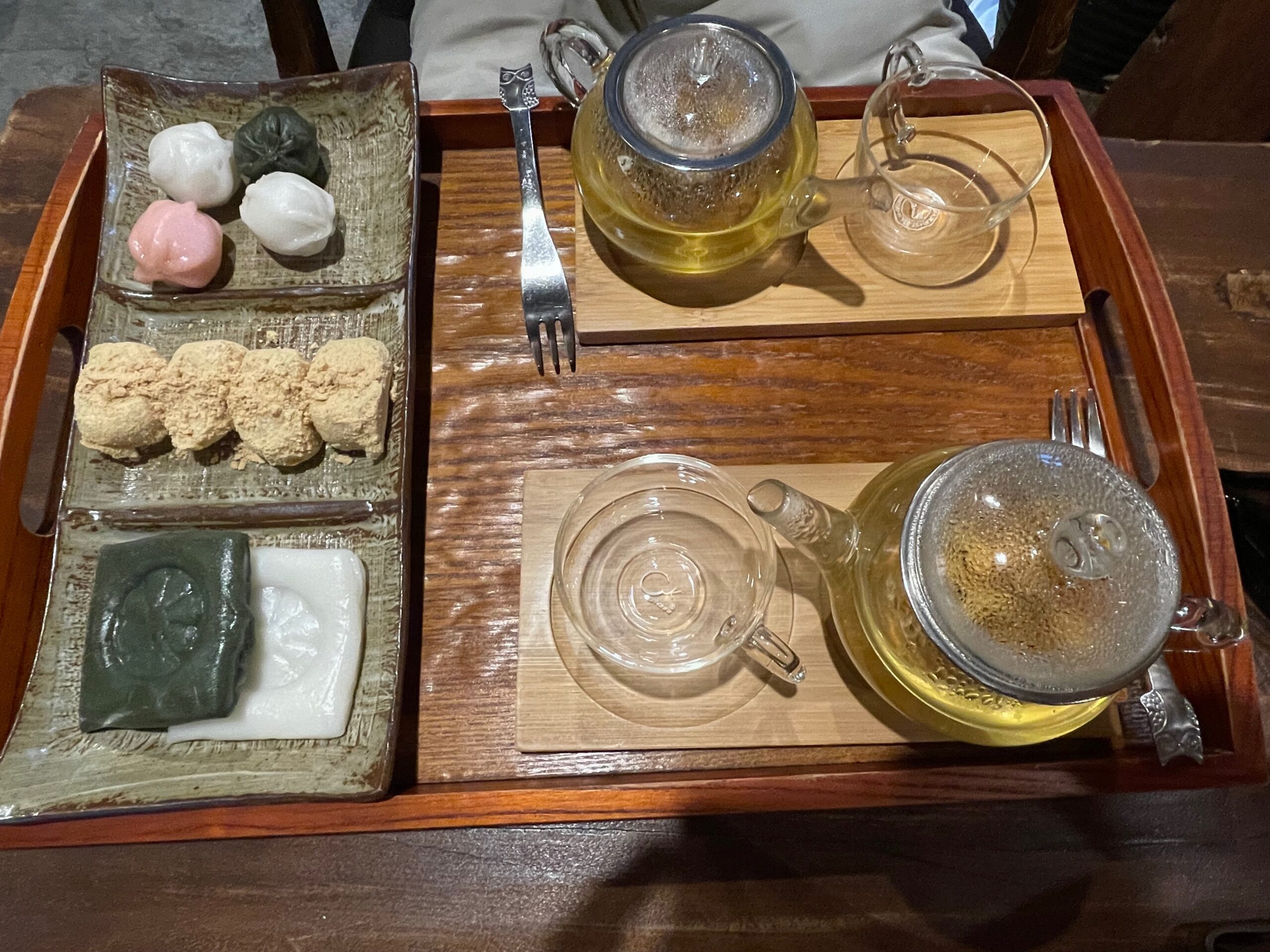 |
If you have a sweet tooth or want to bring a box of Korean sweets to your loved ones, Korean sweets are a very good souvenir idea. You can try to get a box of Hangwa which is a diverse category of traditional Korean sweets and confections. These delicacies have been an integral part of Korean culture for centuries and are enjoyed on special occasions, holidays, and as everyday snacks. Hangwa come in a wide variety of shapes, colors, and flavors, and they are known for their meticulous preparation and intricate designs. You can go for Yakgwa which is a popular Korean honey cookie made from wheat flour, oil, honey, and sesame seeds. Dasik are delicate, bite-sized confections made from rice flour or glutinous rice flour. They are often pressed into decorative molds to create intricate designs and shapes, such as flowers or birds. While tteok is a broad category that includes rice cakes, some tteok can also be considered as Hangwa when they are sweetened and flavored for dessert purposes.
I suggest buying your sweets in confectionery stores so you can ask a seller to provide you information about validity date and storage conditions (especially temperature) so you can be sure that you will bring back your cookies well-preserved. Some of them must be consumed shortly after purchase but it doesn’t sound that bad anyway, an equally nice souvenir is a memory of eating those delicious confections when on your trip around Korea.
12. Korean calligraphy utensils
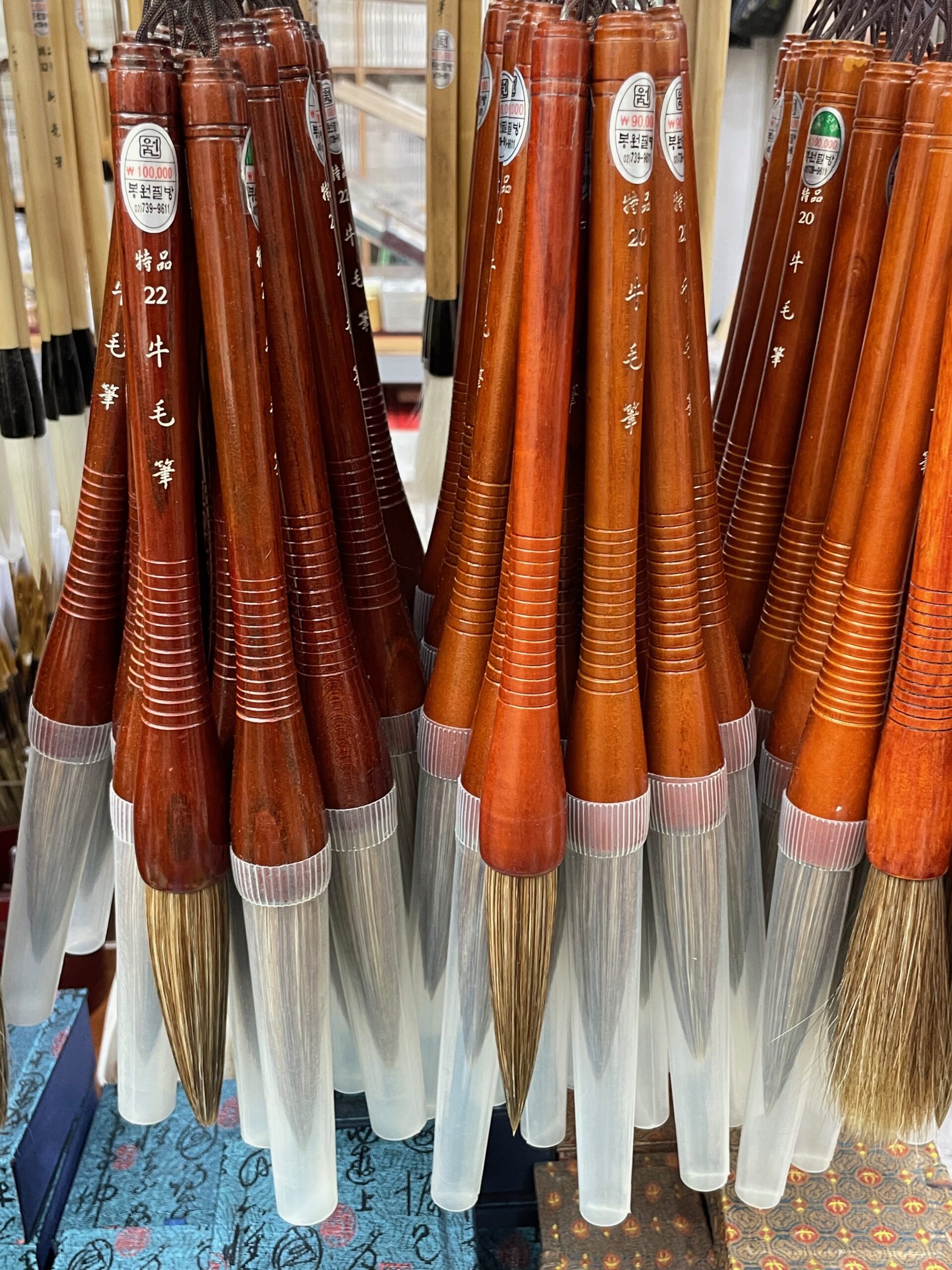 |
Korean calligraphy, known as “Seoye,” is a traditional art form that involves writing and painting with brush and ink. Korean calligraphy tools have evolved over centuries, and they are essential for the creation of elegant and expressive calligraphic works. Tools used in Korean calligraphy are (among others) brush, ink, inkstone and the special paper hanji which is specially designed for calligraphy and painting. It is made from the bark of mulberry trees and is known for its durability and absorbent qualities. Even if you don’t plan to learn Korean you can use various calligraphy products to paint, write and organize your own desk at home. Search calligraphy items in good stationery stores to ensure good quality, durability and great aesthetic. I have also seen some of the calligraphy products in Korean Heritage stores in the Imperial Palaces in Seoul.
13. Korean wooden ducks
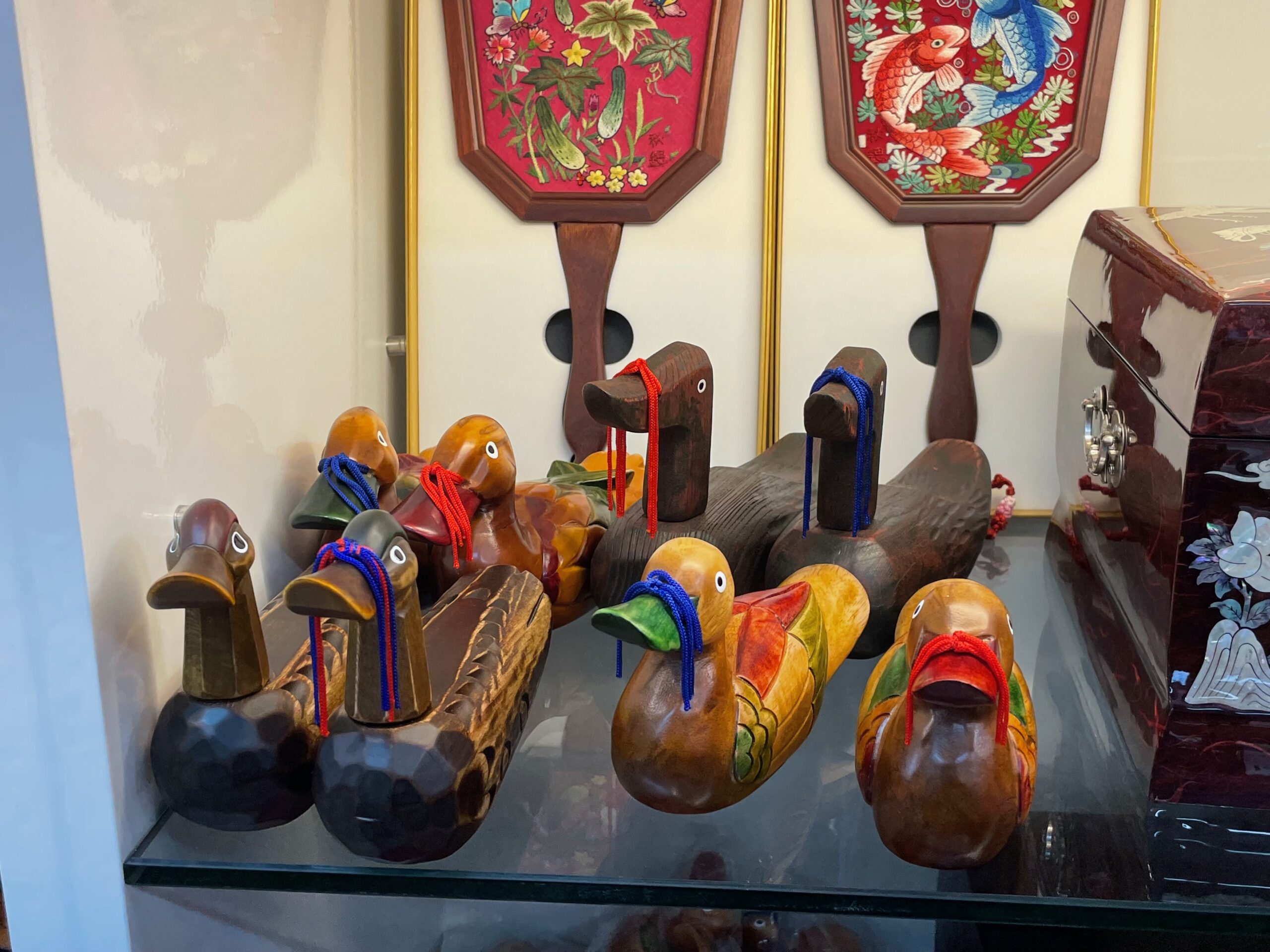 |
Even if the tradition comes from China, the wooden ducks are not just decorative pieces; they have a deep-rooted connection to Korean traditions and customs. Korean wooden ducks are often crafted as a pair, symbolizing fidelity and conjugal harmony. They are considered a talisman of marital bliss and are frequently given as wedding gifts or displayed in newlywed couples’ homes. The idea is that the ducks, known for their monogamous behavior and devotion to their partners, will bring happiness and longevity to the marriage. Wooden ducks are commonly placed in various settings, including the marital bedroom, to symbolize the bond between husband and wife. I think that this is a great souvenir from Korea especially for couples. Search for beautiful handcrafted pieces made in Korea. I have seen a vast selection of ducks in various sizes and patterns in the souvenir shops in Gwangjang Market and in the stores in Insan-dong area. Check few shops before the purchase since the pattern which you really like.
14. Hanji accessories
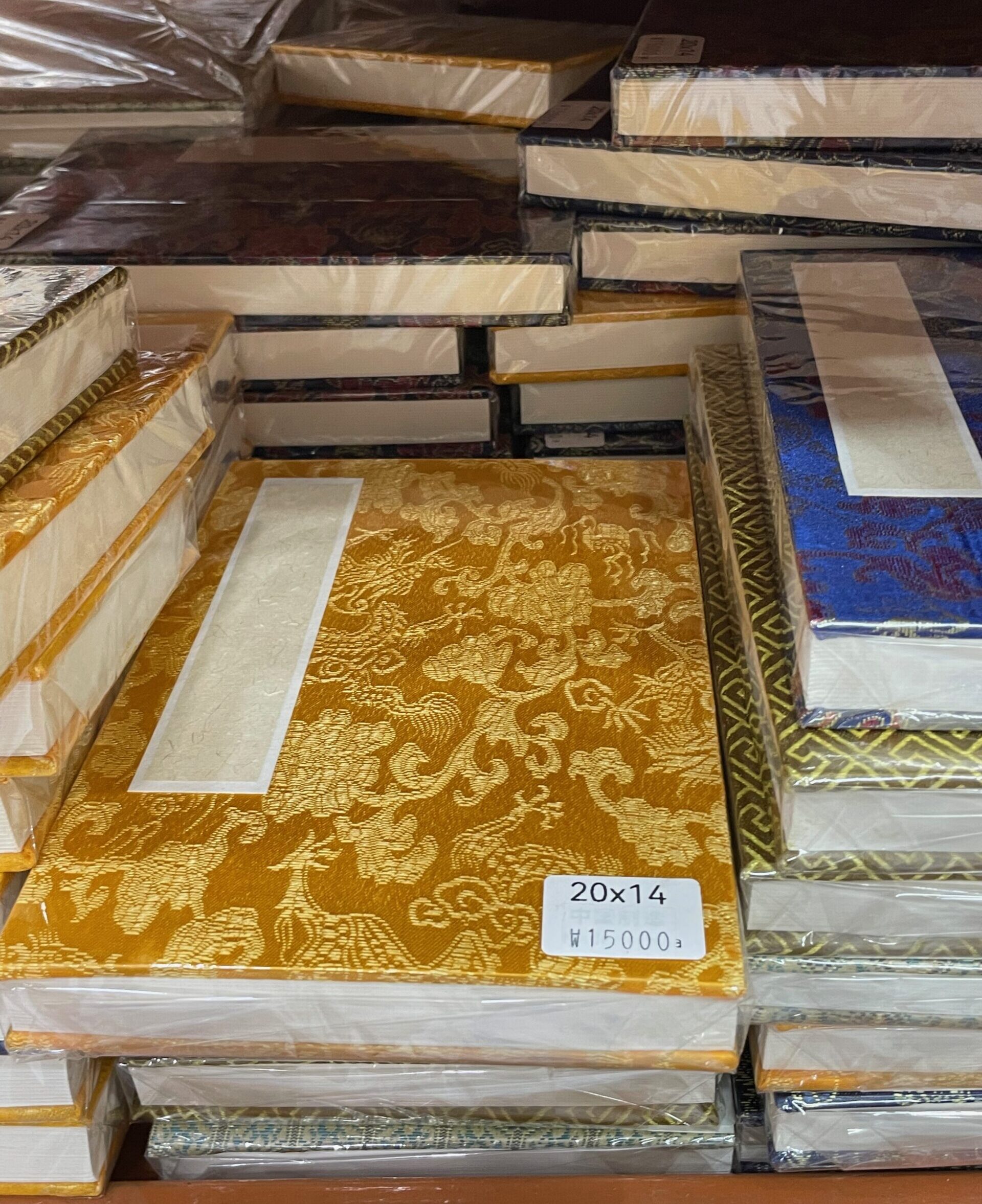 |
Hanji is a traditional type of handmade paper made from the inner bark of the mulberry tree. It has been an integral part of Korean culture for over a thousand years. Hanji is renowned for its durability, versatility, and unique qualities that set it apart from other types of paper. Hanji is often used for calligraphy and painting due to its smooth texture and durability. You can also find Korean fans made on hanji, lanterns, jewelry, boxes and containers. Hanji stationery items, such as journals, notepads, and greeting cards, are also popular for their unique texture and aesthetic appeal. Products made of hanji can be pricey, however smaller items like notepads or greeting cards should still be affordable. Search for artisanal products in more traditional stores in Insan-dong area.
15. Korean tea utensils
As mentioned before Korea of famous of many types of high quality teas. If you like taking your time for tea brewing or just purchase some items which will remind you about Korea whenever you prepare and drink your tea then it may be a good idea to search for Korean traditional teapot (typically small and made of porcelain or ceramic), set of tea cups (usually small and shallow, they are designed to help savor the aroma and taste of the tea), tea strainer, brazier, mats and other utensils which will make your tea drinking an unique experience when back home.
16. Souvenirs from the DMZ
If you go for an organized tour to the Demilitarized Zone (DMZ) between South and Norh Korea you probably would want to bring some small item to remind you about this fascinating experience.
Check here for my post about my visit to the DMZ:
Tour to the Demilitarized Zone in South Korea – practical guide.
When in the DMZ you will find few souvenir shops but most of them sell items which can be find in any other shop in Korea. However, you can get few unique and rare items which can be purchased in the DMZ and are hard to get in other parts of South Korea. One of them are sets of stamps from North Korea with different themes and patterns; another interesting item is the piece of the wire fence from the DMZ. It is being sold with a certificate of authenticity. Another interesting product is package with a combat ration of Korean military which will give you a glimpse of a diet of Korean soldiers.
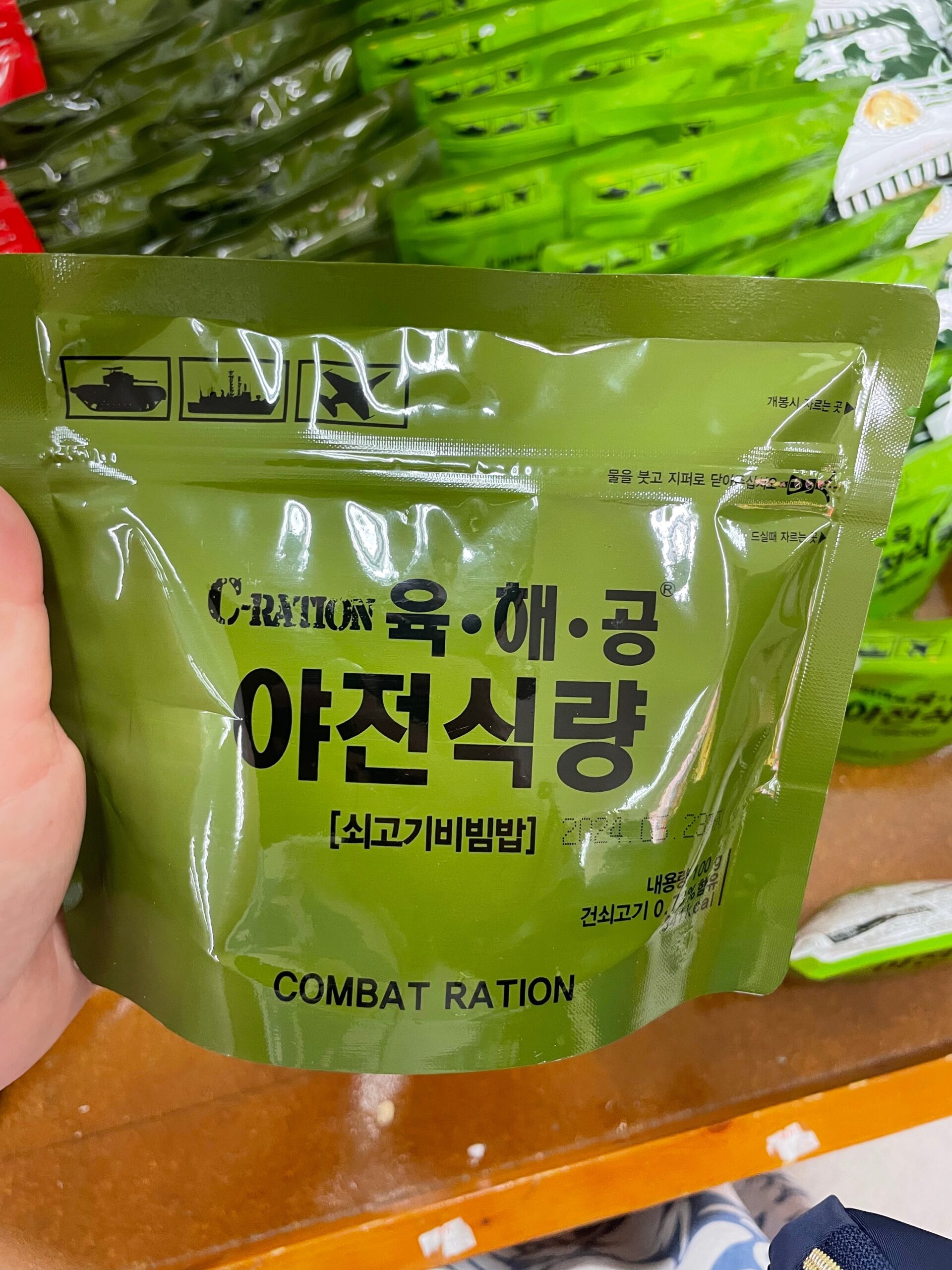 |
17. Korean bookmark
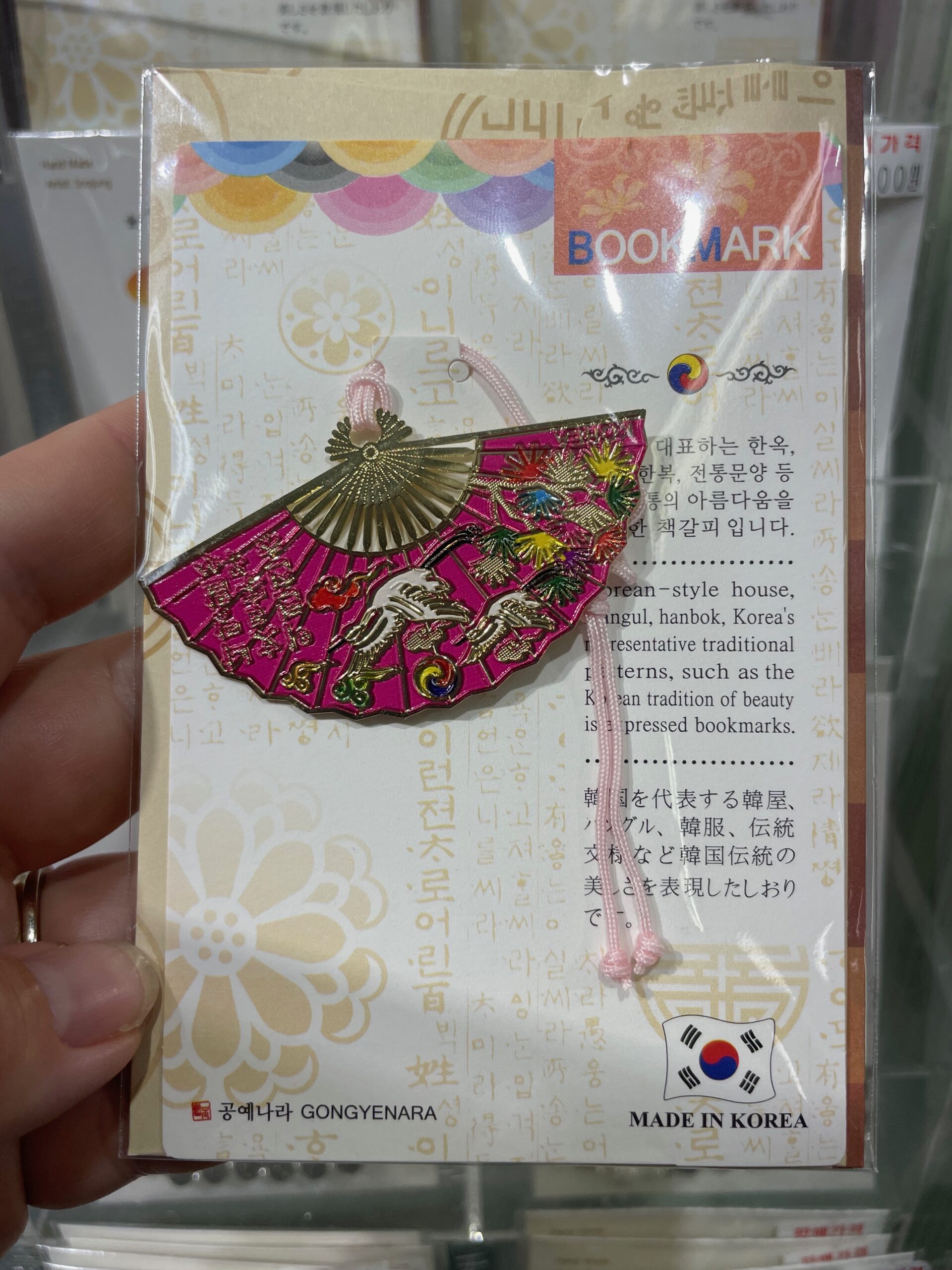 |
This is a perfect beautiful affordable featherlight small gift you can bring back home in big quantities. Traditional Korean bookmarks are quite different to those we’re used to in the Western world. Korean bookmarks come in a variety of designs, but they often incorporate elements of traditional Korean art and culture. Some common motifs include hanbok (traditional Korean clothing), calligraphy, Korean characters, nature-inspired designs, and symbols from Korean folklore. The materials used for Korean bookmarks vary as well, with some made from silk, metal, hanji (traditional Korean mulberry paper), or even fabric.
You can search for beautiful Korean bookmarks in larger bookstores, stationery shops or those specializing in products made of hanji. I found my beautiful bookmar in the souvenir store in the DMZ zone.
18. Korean snacks and food
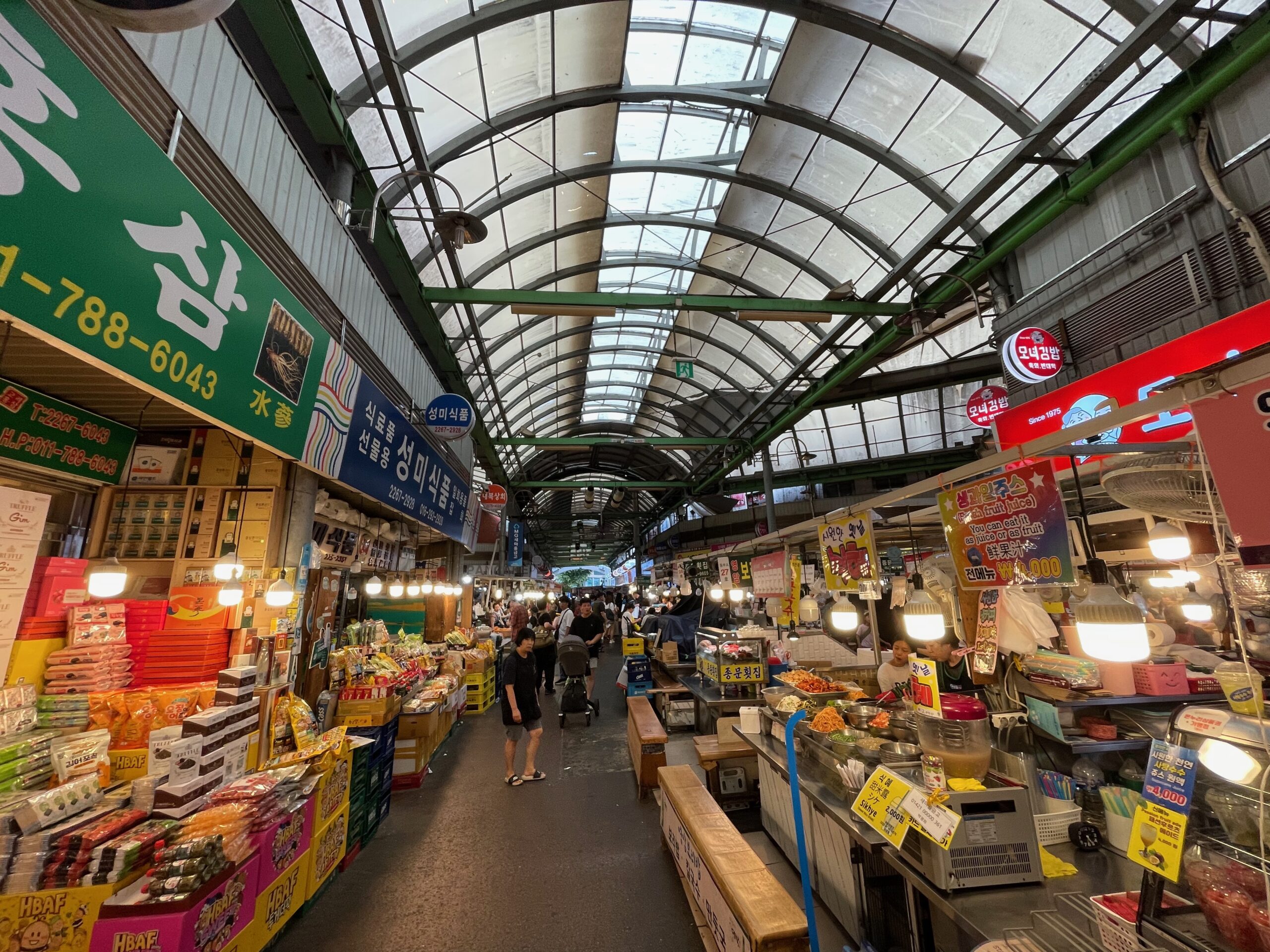 |
Korean popular snacks offer a diverse and delicious array of flavors and textures that cater to a wide range of tastes. From sweet to savory, crunchy to chewy, Korean food may surprise you! If you want to bring some food home as a gift to someone I recommend checking out:
- roasted seaweed snacks (known as “gim” in Korean, are a healthy and savory snack. They come in thin, crispy sheets seasoned with various flavors like sesame, salt, or wasabi;
- dried squid snacks (these chewy and savory snacks, made from dried squid, are a favorite among Koreans. They are often seasoned with a variety of flavors);
- rice crispy snacks;
- instead food like ramyeon (ramen), tofu, or kimchi; those are usually sold in packages which are safe to put in your luggage.
For Korean snacks and instant food, just make some search in local supermarkets, choose bigger branches for wider selection; you can check few of them yourself before buying bigger quantity as a gift. Or just choose something fun where just the package intrigued you and get everyone surprised with new flavors and textures.
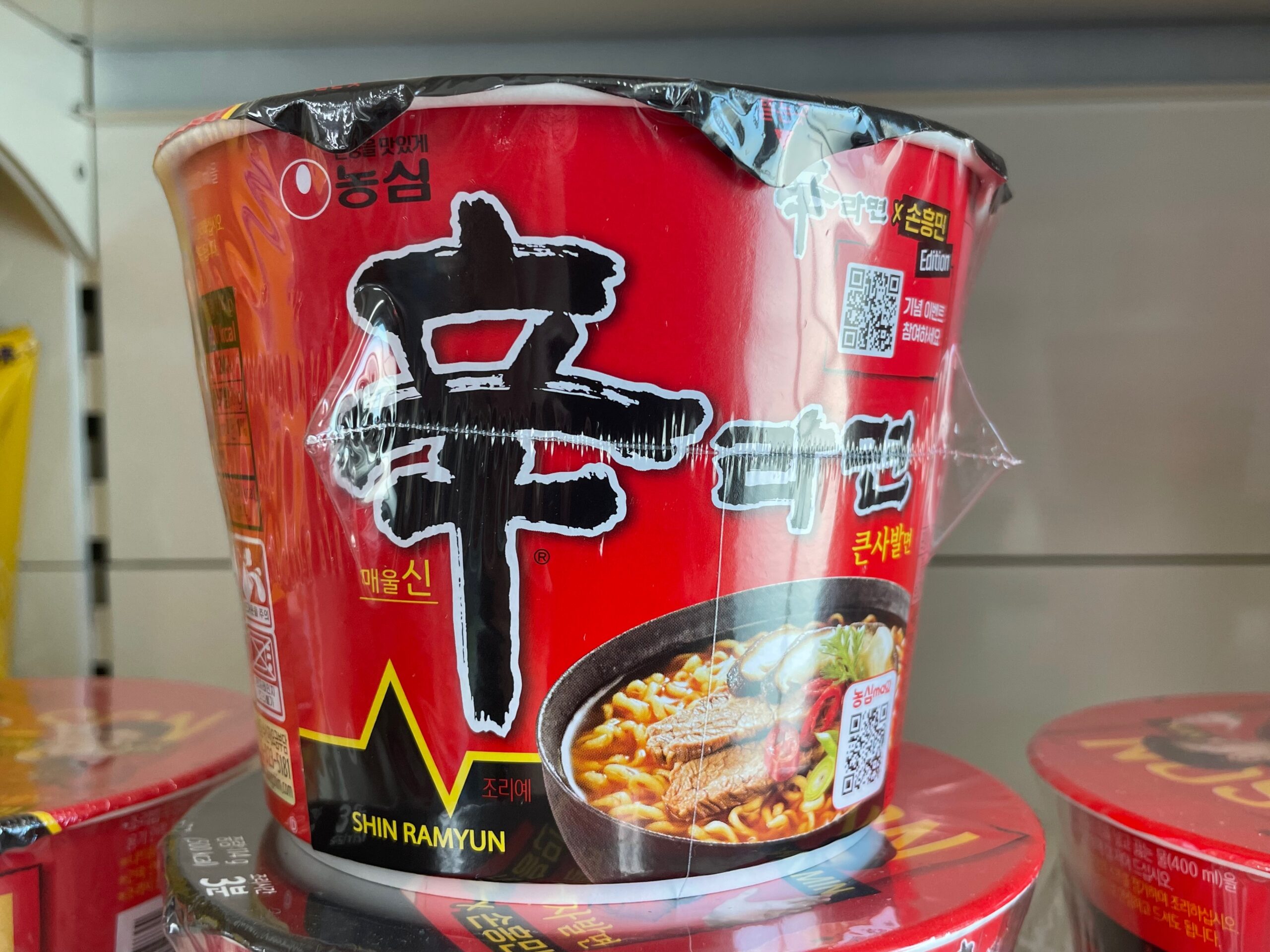 |
19. Mother of pearl traditional Korean furniture
If you search for a high caliber souvenir you can go for a beautifully designed mother of pearl traditional Korean furniture, around Seoul one can find artisanal shops selling various types of furniture, including cabinets, tables, screens, and jewelry boxes, each adorned with intricate mother-of-pearl inlays. As in the case of smaller boxes furniture they often incorporate traditional Korean motifs and symbols. Common themes include birds, flowers, animals, landscapes, and intricate geometric patterns. These motifs are chosen for their cultural and symbolic significance, adding depth and meaning to the furniture’s aesthetics. The creation of the traditional furniture is a labor-intensive and meticulous process. Craftsmen carefully cut and shape the mother-of-pearl pieces, often no thicker than paper, into designs that can be incredibly intricate and detailed. These pieces are then skillfully adhered to the furniture’s wooden surface with natural lacquer, which both secures the inlays and provides a glossy finish. This laborious process is reflected in price, the Korean traditional furniture pieces are on the expensive side. However, if you have a budget and like to adorn your house in items from your travels this can be a very good idea for a high-quality and functional souvenir. I suggest checking artisanal stores and workshops specializing in mother of pearl furniture to find your beautiful piece.
20. Hanbok accessories
I don’t usually recommend buying a traditional national costume since I don’t find them a practical souvenir. This goes also for hanbok which is really a stunning garment but I don’t think one can have many opportunities to wear it outside of Korea. However, the traditional Korean hanbok comes with many beautiful accessories which can be used every day in your home country too. I recommend checking out binyeo which is a traditional Korean hairpin used to secure and decorate the hair. They come in various shapes and sizes, often made from materials like wood, metal, or jade. Another interesting accessory is bokjumeoni which is a small silk pouch often used as a purse. It can be embroidered or adorned with intricate designs and you can use it to organize your jewelry or small items in your day bag or inside of shelves.
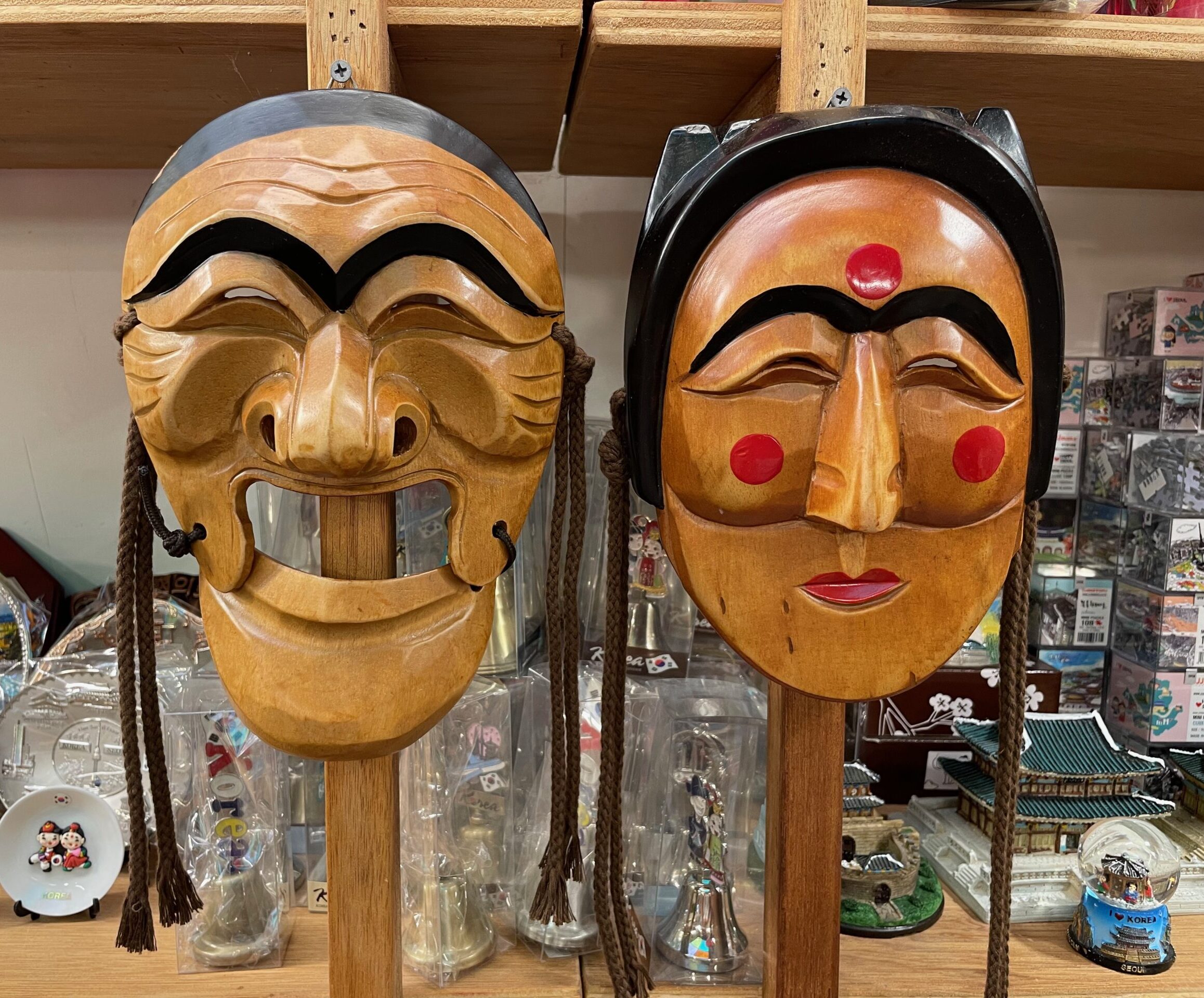 |
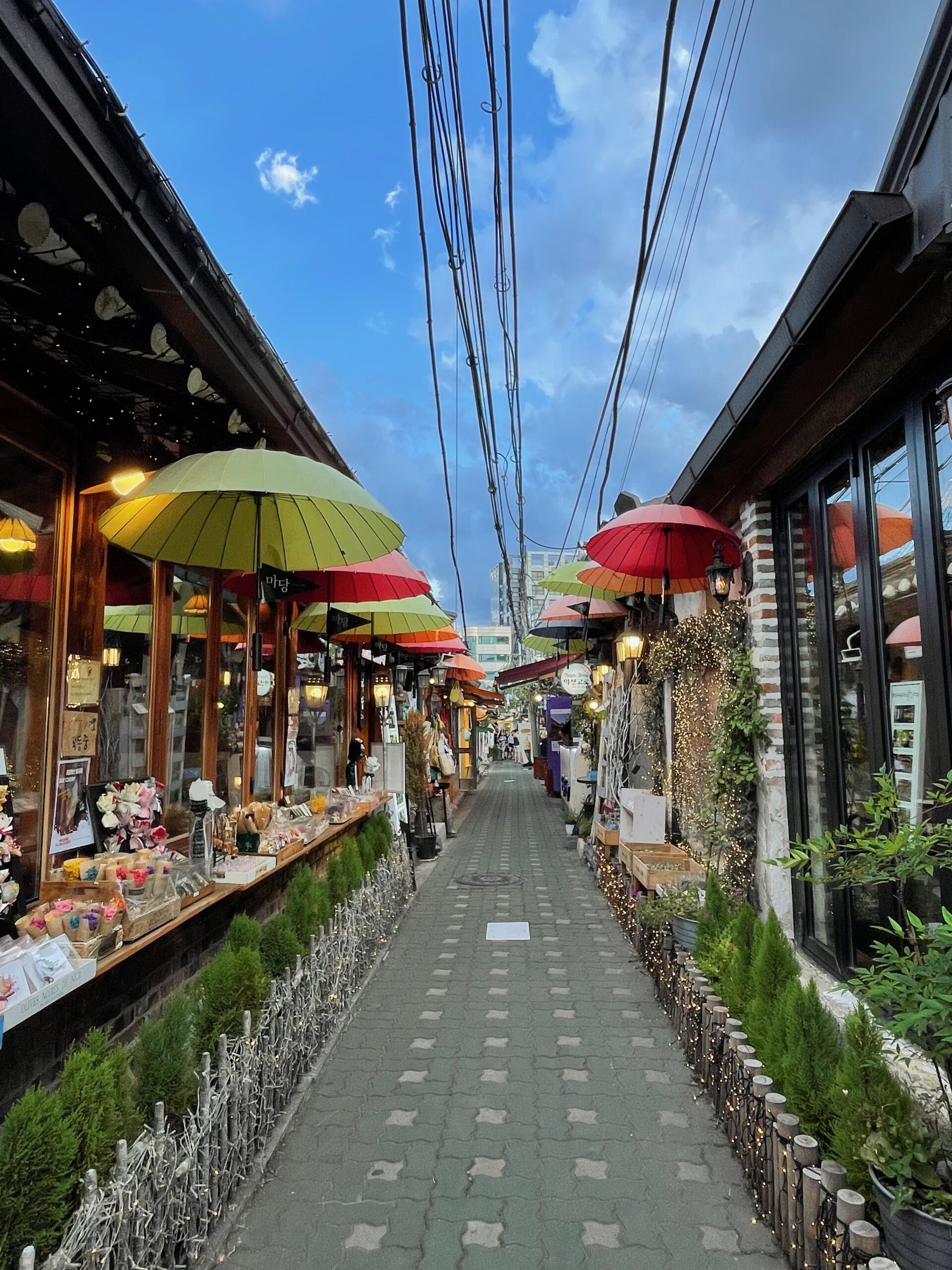
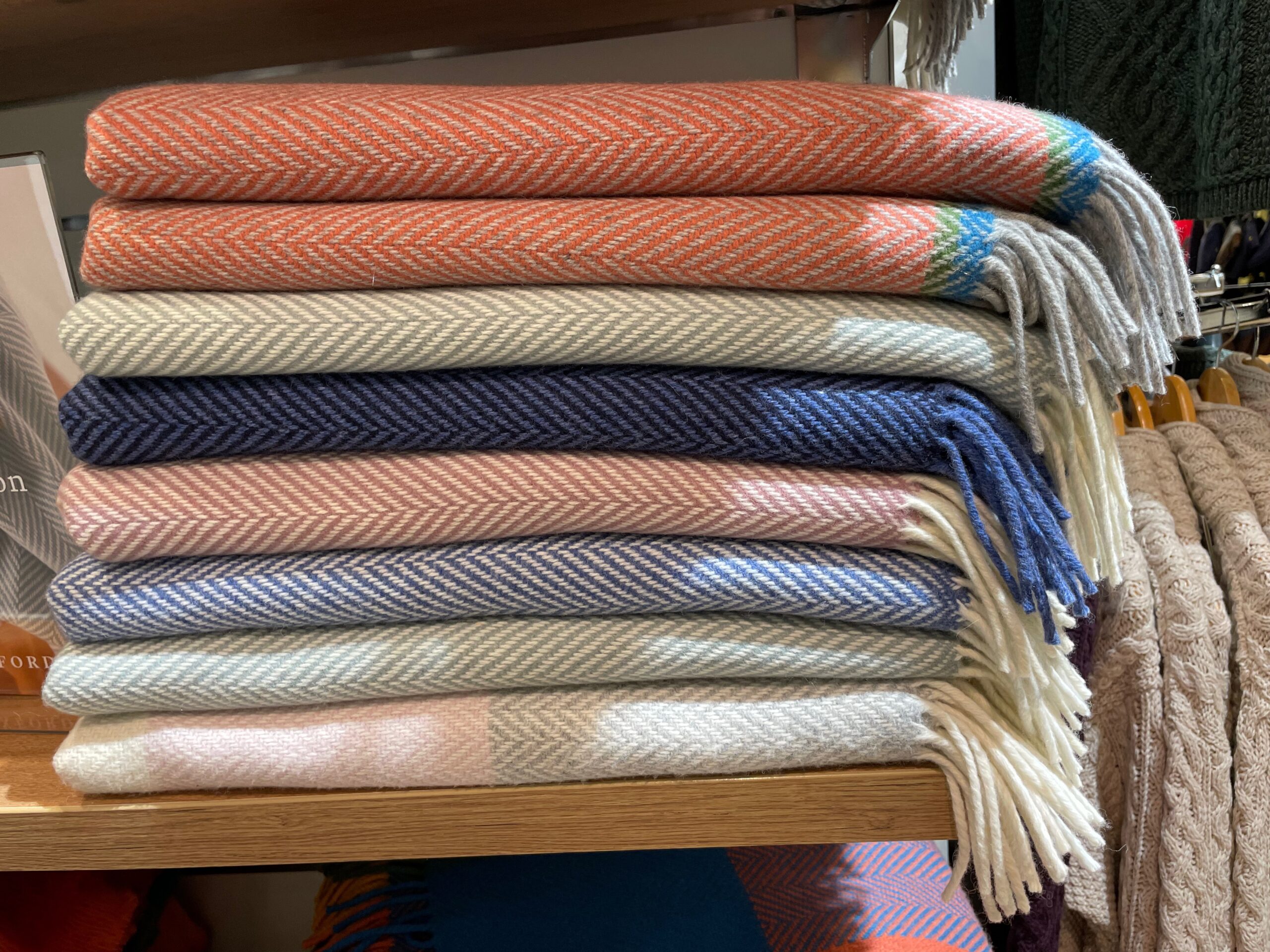
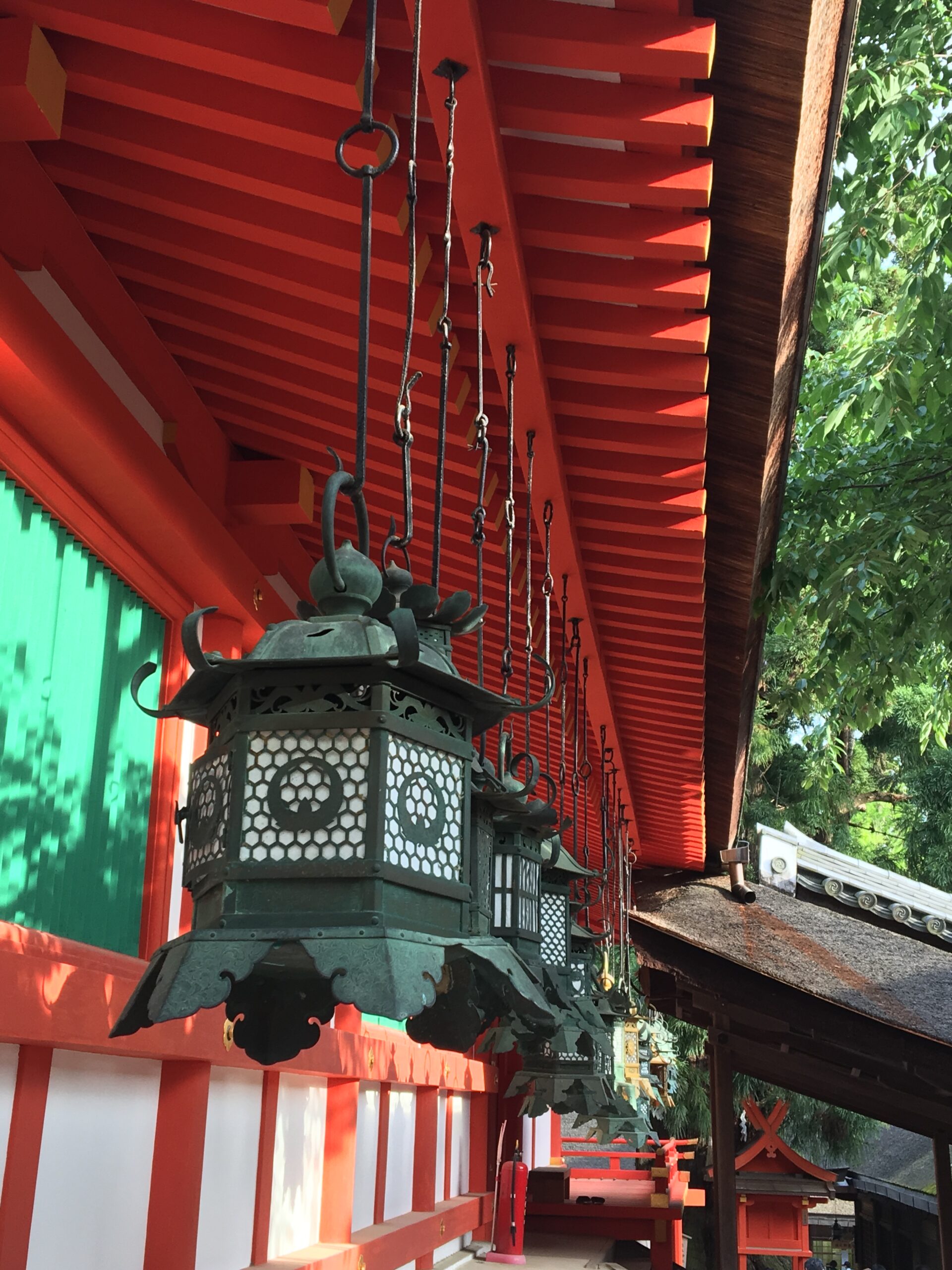

Last time I was in South Korea I bought plenty of ginseng products, the offer is amazing there!
Wow, wonderful weblog structure! How long have you been running a blog for?
This post is so comprehensive, I’ll use this list when shopping in Seoul myself!